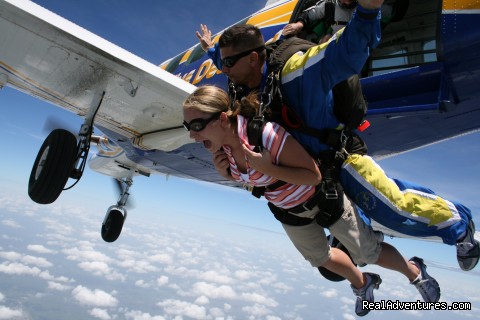Did you ever wonder to say
Did You ever Wonder to Say
Did you ever Wonder to Say
Well Adventure Enthusiasts, Here comes "HTC" with a Bang!! to make you feel your soul in the sky.
Sky-Diving Camp Details
| Dates | Days | Place |
|---|---|---|
| 27th – 29th Sept 2013 | Friday, Saturday & Sunday | Madhya Pradesh |
Static Line Jump

Static Line Skydiving offers the individual an opportunity to jump from an aircraft, on his or her own, from an altitude of 4000 feet using an automatically opened parachute. The main parachute is deployed using a device called a 'static line'. This is a length of webbing attached to the aircraft at one end and the bag in which the main parachute is packed at the other. As the jumper falls away from the aircraft, the static line pulls the main parachute out and begins deployment. Static Line Parachute Jump requires (8 hours) one to two days of ground training followed by the skydive. Student will be assisted by one instructor in the aircraft for the jump and by one the ground to ensure proper safety and safe landing.
| Type of Jump | Height | Cost MRP | Ground Photos | Aerial Exit Shots | Exit Videos |
|---|---|---|---|---|---|
| Static Line Jump | 4000 Feet | 15000/- | Available & Included in Price | Additional Cost of 500/- rs | Additional Cost of 500/- rs |
Tandem Jump

Tandem skydiving is a very popular training method for first time skydivers and it exposes first-time jumpers to skydiving with minimal expectations from the student. The training may consist of many of the activities performed by any skydiving student, for example, how to exit the aircraft, how to do manoeuvres in free fall, and how to deploy the main canopy themselves. However, the tandem master remains primarily responsible for safe and timely parachute deployment.
Tandem skydiving requires equipment with several differences from normal sport skydiving rigs. All modern tandem skydiving systems use parachute, which is deployed shortly after leaving the plane in order to decrease the skydivers' terminal velocity. This is necessary for proper parachute deployment, lengthening the duration of the skydive, and allowing the skydivers to fall at the same speed as video-graphers. Tandem skydiving systems also use larger main parachutes (360 square feet and larger) to support the additional weight of two passengers. The FAA requires tandem parachute rigs to be equipped with a main and reserve parachute, as well as an Automatic Activation Device (AAD), a safety device that automatically deploys the reserve parachute if it detects that the skydivers are still at freefall speed below a certain altitude
| Type of Jump | Height | Cost MRP | Ground Photos | Aerial Exit Shots | Exit Videos |
|---|---|---|---|---|---|
| Tandem Jump | 10,000 Feet | 32,500 | Available & Included in Price | Available & Included in Price | Available & Included in Price |
Day 1: September 26th(Thursday) : Clock: 23:00hrsTentative ITINERARY:
We will board the train to destination.
Day 2: September 27th (Friday):
We will reach base, Take rest and get prepared for the Ground training
Day 3: September 28th (Saturday):
Training Time
Day 4: September 28th (Sunday):
When U know Adrenaline is Legal :P :) Lets Fall with Style :)
Day 5: September 29th (Monday): Clock: 10:00hrs
Reach Home and share the experiences with the world.
Damages:
Total Cost for Static Line Jump: 21,000/- rs (Inclusive of Aerial exit shots & Videos)
Total Cost for Tandem Jump: 37,500/- rs ( Inclusive of Aerial exit shots & Videos)
Meetup Cost Break down
Dive Cost: 15000/- or 32,500 (Depends on Which jump you Choose)Transport/Accommodation/Club fund : 5000/ rs approx. (Food & Water Excluded.
Refund Policy :
1) We will refund 100% in case camp gets cancelled because of any reason from our side like bad weather etc.
2) In case , you need to cancel your booking 1 week prior the date of jump, your 100% amount will be refunded.
3) In case of any cancellation of booking 3 days prior to date of jump, 50% of amount will be refunded.
4) In case of any cancellation on the day of your jump, no money will be refunded . However, if we are timely informed, you can avail your jump in any of our skydiving camps in the Dropzone.
Medical Requirement for taking skydiving :-
1) One should be physically fit and weight has to be below 90 kg for static, TANDEM & AFF. 2) It is always good if does not have any history of high BP, cardiac problems or serious back/neck injuries.
HTC Club Guidelines Subscribe to ★✌LĔŤMĔŔULĔ✌★ by Email Continue Reading......







